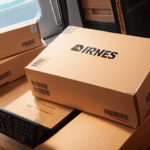UPS Outlines Comprehensive Guidelines for Shipping Consumer Commodities
UPS, one of the world's largest package delivery companies, has recently updated its guidelines for shipping consumer commodities. These guidelines aim to ensure safety, compliance, and efficiency in the transportation of a diverse range of goods. This article provides an in-depth analysis of UPS's rationale behind these guidelines, explores the associated risks and compliance issues, and highlights the key features of the guidelines. Additionally, we offer practical tips for preparing consumer commodities for shipment.
Why UPS is Issuing Enhanced Guidelines for Consumer Commodities
Shipping consumer commodities involves navigating a complex landscape of safety and regulatory challenges. These commodities range from everyday household items, such as cleaning products and batteries, to specialized goods like electronics and hazardous materials. UPS has introduced detailed guidelines to mitigate the risks associated with transporting these materials, ensuring the safety of both handlers and recipients.
One primary motivation for UPS's updated guidelines is to enhance the safety of handling and delivery personnel. Improper packaging or labeling can pose significant threats, leading to potential injuries or legal repercussions for the shipper. According to the UPS Safety Resources, strict adherence to packaging standards reduces the likelihood of accidents and ensures compliance with international regulations.
Furthermore, these guidelines aim to streamline the shipping process, minimizing delays and reducing the risk of damage to goods. By following UPS's packaging and labeling procedures, shippers can ensure timely and intact delivery of their packages.
Understanding the Definition of Consumer Commodities
"Consumer commodities" refer to materials intended for personal or household use. This broad category includes products like personal care items (e.g., shampoo, soap), household cleaning supplies, and even food items such as canned goods and packaged snacks. Importantly, this category also encompasses certain hazardous materials, including specific chemicals and batteries, which require special handling and packaging.
Proper labeling and packaging are crucial for the safe transport of consumer commodities. This involves using appropriate materials and providing necessary warnings or handling instructions on the package. Failure to do so can result in product damage, environmental harm, or injury to those handling the package.
The Risks Associated with Shipping Consumer Commodities
Shipping consumer commodities presents several risks for both shippers and recipients. These risks include:
- Damage to goods during transit
- Personal injury from mishandled or hazardous items
- Environmental hazards due to improper packaging
According to a report by the Boston Consulting Group, improper packaging is one of the leading causes of shipping-related injuries and environmental incidents. UPS's guidelines address these issues by providing clear instructions on using suitable packaging materials like bubble wrap and packing peanuts and ensuring packages are securely sealed.
The Importance of Compliance in Shipping Consumer Commodities
Compliance with shipping regulations is essential to ensure the safe and legal transportation of consumer commodities. UPS's guidelines align with global compliance standards, simplifying the process for shippers to adhere to necessary regulations.
Proper labeling is a critical aspect of compliance. Packages must include accurate descriptions of their contents, along with any required warnings or hazard symbols. Non-compliance can lead to delays, fines, or legal action. For instance, the Federal Aviation Administration (FAA) strictly regulates the transportation of hazardous materials, and failure to comply can result in significant penalties.
In addition to labeling, compliance involves using appropriate packaging materials and following guidelines for handling hazardous substances. By adhering to these regulations, shippers can ensure the safe and timely delivery of consumer commodities.
How UPS Guidelines Ensure Safe and Secure Transportation of Consumer Commodities
UPS's guidelines encompass several factors that contribute to the safe transportation of consumer commodities, including:
- Packaging: Using materials that protect contents and prevent leakage or damage.
- Labeling: Clear and accurate labels that convey necessary information.
- Regulatory Compliance: Adhering to local and international shipping regulations.
Additionally, UPS employs advanced technologies and security measures to safeguard shipments. Real-time tracking and monitoring provide transparency and allow for prompt responses to any issues that may arise during transit. UPS's Supply Chain & Logistics solutions integrate artificial intelligence to optimize routing, enhancing efficiency and reducing the risk of delays.
By leveraging these technologies, UPS ensures that consumer commodities are handled securely and reach their destinations safely.
Key Features of the UPS Guidelines for Shipping Consumer Commodities
The UPS guidelines for shipping consumer commodities include comprehensive instructions on various aspects, such as:
- Required Packaging Materials: Specifies the use of cushioning materials and sturdy containers to protect contents.
- Proper Labeling: Ensures that package contents are clearly identified, including any hazard warnings.
- Regulatory Compliance: Guidance on adhering to shipping regulations, especially for hazardous materials.
- Special Handling Instructions: Covers the handling of fragile items, liquids, and other sensitive products.
Proper documentation is another critical feature of the guidelines. Accurate information about package contents, permits, and licenses must accompany shipments. Incomplete documentation can lead to shipment delays or fines.
For perishable items such as food or pharmaceuticals, the guidelines recommend using insulated packaging and refrigerants to maintain appropriate temperatures during transit. Timely delivery is emphasized to prevent spoilage, ensuring the quality and safety of these products upon arrival.
Preparing Your Consumer Commodities for Shipment: A Step-by-Step Guide
To comply with UPS guidelines, follow these essential steps for packaging and labeling your consumer commodities:
- Choose Sturdy Containers: Select containers appropriate for your package's contents to ensure durability during transit.
- Add Cushioning Materials: Use bubble wrap, packing peanuts, or other cushioning materials to prevent damage.
- Label Clearly: Include detailed information about the contents and any necessary regulatory information or hazard warnings.
- Include Documentation: Provide all required regulatory documents, such as permits or licenses, especially for hazardous materials.
- Seal Securely: Ensure the package is tightly sealed to prevent opening or damage during shipping.
Different consumer commodities may have specific packaging and labeling requirements. For example, shipping hazardous materials necessitates additional labeling and documentation to comply with regulations such as those outlined by the Occupational Safety and Health Administration (OSHA).
Choosing the right shipping method and carrier is equally important. Some carriers have specific restrictions or requirements for certain types of commodities. Ensure you select a carrier experienced in handling your particular goods to guarantee safe and timely delivery.
Common Mistakes to Avoid When Shipping Consumer Commodities
Even with clear guidelines, shippers can make mistakes that compromise the safety and efficiency of their shipments. Common errors include:
- Poor packaging that lacks adequate cushioning or protection.
- Incomplete or inaccurate labeling of packages.
- Incorrect identification or labeling of hazardous materials.
- Omitting required documentation from the package.
Additional mistakes to avoid:
- Temperature Mismanagement: Failing to maintain required temperatures for perishable items can lead to spoilage or damage.
- Improper Sealing: Packages that are not securely sealed may open during transit, resulting in loss or damage of contents.
To prevent these issues, always adhere to UPS's guidelines and double-check your packaging and labeling before shipment.
Benefits of Using UPS for Shipping Your Consumer Commodities
UPS offers numerous advantages for shipping consumer commodities, including:
- Expert Guidance: Detailed instructions on packaging and labeling requirements ensure compliance and safety.
- Global Regulatory Compliance: Adherence to international shipping standards simplifies the process for global shipments.
- Risk Reduction: Proper packaging and handling minimize the risk of damage or loss during transit.
- Efficient Transportation: Reliable and secure shipping services ensure timely delivery of your packages.
How UPS is Innovating to Improve the Transportation of Consumer Goods
UPS continually invests in innovative solutions to enhance the transportation of consumer goods. Key innovations include:
- Advanced Tracking Technology: Real-time tracking systems provide detailed information on package location and status, offering greater transparency and control.
- Artificial Intelligence Integration: AI optimizes routing and transportation efficiency, reducing delivery times and operational costs.
- Eco-Friendly Packaging: New materials and designs aim to reduce waste and improve the safety of shipments, supporting sustainability initiatives.
These innovations not only improve the shipping experience but also contribute to environmental sustainability and operational efficiency.
The Role of Technology in Ensuring Safe and Efficient Shipment of Consumer Commodities
Technology plays a pivotal role in modern shipping processes, enhancing both safety and efficiency. UPS leverages several technological advancements to ensure the secure transportation of consumer commodities:
- Real-Time Tracking: Provides continuous updates on package status, allowing shippers and recipients to monitor shipments closely.
- Artificial Intelligence: AI-driven systems optimize delivery routes, reduce transit times, and improve fuel efficiency.
- Automated Sorting Facilities: Enhance the speed and accuracy of package handling, minimizing errors and delays.
By integrating these technologies, UPS ensures that consumer commodities are shipped safely, efficiently, and with minimal environmental impact.
Comparison of UPS Guidelines with Other Industry Standards
Various industry standards exist for shipping consumer commodities, each with its own set of regulations and best practices. Comparing UPS's guidelines with other standards can help shippers make informed decisions about their shipping partners.
UPS's guidelines are aligned with global compliance standards, such as those set by the International Civil Aviation Organization (ICAO) and the International Air Transport Association (IATA). These guidelines are regularly updated to reflect changes in regulations and industry best practices, ensuring that shippers remain compliant with the latest requirements.
In comparison, other carriers like FedEx and DHL also adhere to strict compliance standards but may offer different additional services or focus areas. Evaluating the specific needs of your shipment, such as the types of commodities, destination, and required delivery speed, will help determine which carrier’s guidelines best suit your requirements.
Conclusion
Shipping consumer commodities involves navigating numerous challenges, including safety, compliance, and efficiency. By adhering to UPS's comprehensive guidelines, shippers can mitigate risks, ensure regulatory compliance, and achieve timely and secure delivery of their packages. UPS's continuous innovation and commitment to advanced technologies further enhance the shipping experience, providing reliable and sustainable solutions for transporting consumer goods.
Whether you are a large business or an individual sender, following UPS's guidelines ensures that your consumer commodities are handled with the utmost care and professionalism. Embrace these best practices to enjoy efficient and reliable transportation for all your shipping needs.






















